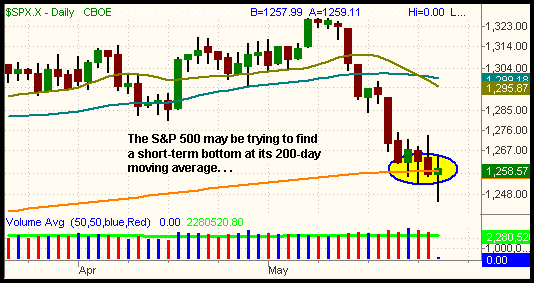Stocks traded in an indecisive and choppy fashion yesterday, but the major indices finished with modest gains on higher volume. The broad market rallied in the first hour of trading, sold off into mid-day, then recovered in the final two hours. Trading in an opposite pattern to the previous day's action, the Nasdaq Composite turned a 1% intraday loss into a 0.5% closing gain. Both the S&P 500 and Dow Jones Industrial Average gained 0.2%, while the small-cap Russell 2000 was unchanged. The only major index to finish lower was the S&P Midcap 400, which slid another 0.2%. Since the broad market selloff began on May 10, mid-cap stocks have shown the most relative weakness of the major market segments. The S&P Midcap 400 has closed lower in 11 of the last 12 sessions and has suffered an 8% loss throughout that period. This compares to a 7.5% loss in the Nasdaq and 5.0% in the S&P 500. Knowing which market segments are showing the most relative weakness improves your odds of a profitable short trade because those are the stocks that will bounce the least when the broad market does and will be the first to set new lows when the market goes back down.
Confirming yesterday's bullish reversal attempt was an increase in turnover across the board. Total volume in the NYSE was 18% higher, while volume in the Nasdaq increased by 23% above the previous day's level. Because both the S&P and Nasdaq also closed higher, yesterday was a bullish "accumulation day," although the weak performance of leading stocks was less than impressive. Mixed market internals also failed to confirm the accumulation, as declining volume in the NYSE exceeded advancing volume by a margin of 3 to 2. The Nasdaq internals, however, were positive by the same ratio. The vast quantity of bearish "distribution days" in April and May created a lot of overhead supply that led to the selloff over the past two weeks, but the two "accumulation days" over the past week could help the market to at least find a short-term bottom.
Over the past four days, the S&P 500 has been oscillating around its 200-day moving average. Unlike the Nasdaq, which sliced right through its 200-day MA on May 17, the S&P is actually attempting to find support at this level. This is quite normal, as a major index like the S&P will rarely fall right through its 200-day moving average without first putting up at least a valiant fight. Most institutions use the 200-day moving average as a long-term sentiment on market direction. When the major indices are all sitting below their 200-day moving average, their overall bias tends to be on the sell side, while the long-term bias remains "up" whenever the indices are above their 200-MAs. Without a doubt, all eyes are on whether or not the S&P holds at its 200-MA. As you can see, the S&P 500 closed right on its 200-day MA yesterday:

Both the Russell 2000 and S&P Midcap 400 indices touched support of their 200-day MAs yesterday, but closed above them. The Dow now remains the only index that has not yet fallen to its 200-MA, although we think it will. The Dow showed relative strength throughout the initial selloff, but has begun to show a bit of relative weakness over the past few days. This is most likely due to sector rotation now coming out of the large cap stocks and is the reason we are now short DIA. We anticipate the Dow will continue to play "catch up" with the losses in the other indices.
Because of the S&P's close proximity to its 200-day moving average, we would take it easy on new short position entries at current levels. This, however, does not mean we would begin a buying spree either. Any rallies in the market are likely to be met with sellers that could easily result in weak price action into the close. But if you decide to dip a toe in the water on the long side of the market, be sure to keep tight stops and consider reduced position size since you are clearly fighting a strong downtrend. As regular subscribers will see, we are stalking one of the fixed-income ETFs for a potential long entry today, but they are not necessarily closely correlated to the broad market's price action. Other than some of the bond fund ETFs, we feel a better option than going long is to wait for a solid 38.2% or 50% Fibonacci retracement in the broad market and then look for new short positions in anticipation of a trend resumption. When the market finally does put in a solid bottom and all the signals confirm such action, there will be plenty of time to begin buying the stocks and ETFs with relative strength. We will be sure to provide you with ideas for the best looking trade setups when the time is right. Until then, cash is king and patience pays big dividends.
Deron Wagner is the Founder and Head Trader of both Morpheus Capital LP, a U.S. hedge fund, and Morpheus Trading Group, a trader education firm launched in 2001 that provides daily technical analysis of the leading ETFs and stocks. For a free trial to the full version of The Wagner Daily or to learn about Wagner's other services, visit MorpheusTrading.com or send an e-mail to deron@morpheustrading.com.